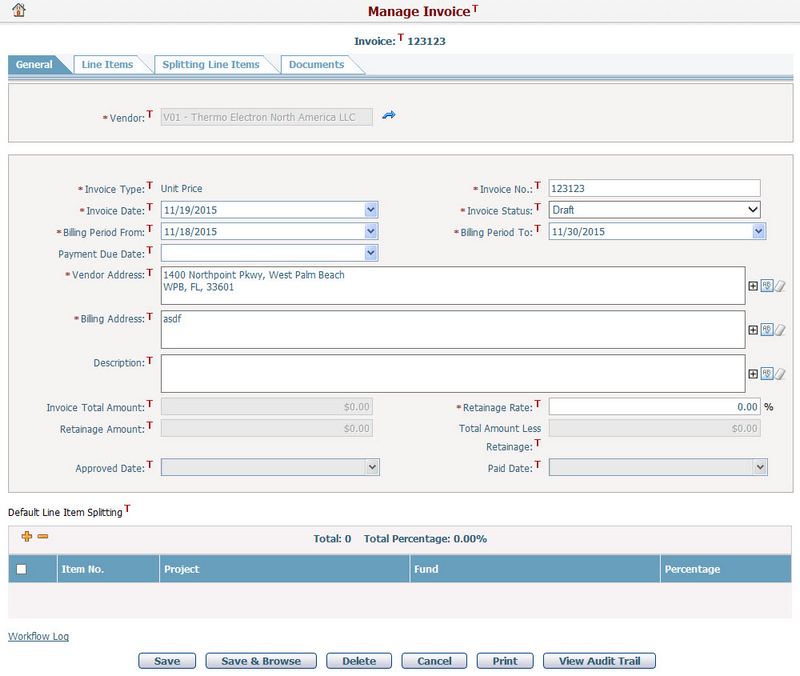Navigate Here: Financials > Invoices > Browse Invoices; select an invoice
You can edit general information of an invoice on its General tab page. An invoice can only be edited when its status is Draft.

The required fields are noted with an asterisk (*).
Vendor*: Vendor which issues the invoice.
Purchase Order*: For PO-Invoice only, it is the specified purchase order which the invoice is issued against.
Contract*: For Contract-Invoice only, it is the specified contract which the invoice is associated with.
Invoice Type*: Type of the invoice.
Invoice No.*: Number of the Invoice.
Invoice Status*: System statuses for invoice.
- Draft: Indicates the initial phase of an invoice. Under this status, you can edit invoice general information, delete the invoice, and add/edit/delete invoice line items.
- Under Review: Indicates the interim phase when the invoice is under approval.
- Approved: Indicates that the invoice is in effect. Under this status, invoice general information and invoice line items cannot be edited.
- Paid: Indicates that the invoice has been paid. Please note that the invoice payment progress which is driven by business flow as follows: Draft > Under Review > Approved > Paid.
- Rejected: Indicates that the invoice fails to get approval. Under this status, you can edit invoice general information, delete the invoice, and add/edit/delete invoice line items.
Invoice Date*: Date of the invoice.
Payment Due Date: Date when payment to the invoice is due.
Billing Period From*: Date when the invoice starts billing from.
Billing Period To*: Date when invoice billing ends. It must be no earlier than Billing Period From.
Vendor Address*: Address of the vendor of the invoice. Default is the address of the vendor but it can be edited.
Billing Address*: Billing address of the invoice. Default is the billing address of the associated purchase order for PO-Invoice but it can be edited.
Description: Description of the invoice.
Invoice Total Amount: Total amount of the invoice. It is the sum of all invoice line items.
Retainage Rate*: Retainage rate of the invoice which will be applied to all invoice line items as default retainage rate. Default is the purchase order's retainage rate (for PO-Invoice) or the contract's retainage rate (for Contract-Invoice).
Retainage Amount: Total retainage amount of the invoice. It is the sum of retainage of all line items of the invoice. Since each line item can have its own retainage rate different from that of the invoice, this amount may not equal to Invoice Total Amount x Retainage Rate.
Total Amount Less Retainage: It equals to Invoice Total Amount - Retainage Amount.
Approved Date: The date when the invoice is approved. It can only be updated by workflow activity.
Paid Date: The date when the invoice is paid. It can only be updated by the system automatically in the invoice payment process.
Click the Save button to save the changes and then go to the Invoice Line Items page.
Click the Save & Browse button to save the changes and then go to the Browse Invoices page.
Click the Delete button to delete the invoice. An invoice can be deleted only if its status is Draft.
Click the Cancel button to go to the Browse Invoices page without adding the invoice.
You can print information of this invoice in Word or PDF format by clicking the Print button. The system will then open the Generate Dynamic Document page.
You can view the change history of this invoice by clicking View Audit Trail button. The system will then open the Browse Audit Trail Details page in a new window.
Default Line Item Splitting
For different invoice types, if the default line item splitting is enabled by configuration, you can add new invoice level split line items in the Default Line Item Splitting section by clicking the Add icon ![]() at the top left corner of the split line item grid or edit any existing split line items on the grid.
at the top left corner of the split line item grid or edit any existing split line items on the grid.
Item No.: Split line item sequence number. It is automatically generated by system.
Project: The implementation project linked to the split line item. Browse and select an implementation project by clicking ![]() .
.
Fund: The fund linked to the split line item. Browse and select a fund by clicking ![]() .
.
Percentage: The default percentage of this split line item.
Note: System will automatically calculate the default split line item percentage for every new entry by [100% - the total of existing split line items’ percentages]. If the result is negative, system will show zero instead.
You can select multiple split line items by the checkbox in front of each line and delete them by clicking ![]() button.
button.
Inspection Reports
The inspection report(s) associated with the current invoice are displayed in the table. A brief summary of each related inspection report includes Report Number, Report Date, Report Status, Inspector, Primary Project and Primary Contract (These columns in the data grid can be configured by Dynamic View). You may sort the records by clicking the linked column header.
You can view the detailed information of an inspection report by clicking ![]() . The system will open the Inspection Report Management page in a new window.
. The system will open the Inspection Report Management page in a new window.
You can associate inspection report(s) with the current invoice by clicking ![]() . The system will pop up a window for selecting inspection report(s), listing all inspection reports in the system except those that are already associated with the current invoice.
. The system will pop up a window for selecting inspection report(s), listing all inspection reports in the system except those that are already associated with the current invoice.
You can disassociate inspection report(s) with the current invoice by selecting the inspection report (s) and clicking ![]() .
.